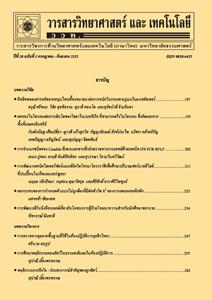การประยุกต์ใช้เครื่องหมายไอเอสเอสอาร์ในการจำแนกและตรวจสอบความผันแปรทางพันธุกรรมของแตนเบียนแมลงวันผลไม้ชนิด Psyttalia fletcheri และ P. incisi (Hymenoptera: Braconidae)
Main Article Content
Abstract
บทคัดย่อ
แตนเบียนในสกุล Psyttalia เป็นศัตรูธรรมชาติของแมลงวันผลไม้หลายชนิด ในประเทศไทยพบแตนเบียนสกุล Psyttalia ที่มีการจัดจำแนกไว้ 3 ชนิด และที่ไม่สามารถจัดจำแนกได้อีกหลายชนิด เนื่องจากมีลักษณะภายนอกที่คล้ายกันมาก แตนเบียนกลุ่มนี้มีแนวโน้มที่จะมีศักยภาพในการควบคุมแมลงวันผลไม้ได้ แต่ยังมีข้อมูลทางด้านพันธุกรรมของแตนเบียนในสกุลนี้ในประเทศไทยค่อนข้างน้อย ดังนั้นการนำเครื่องหมายทางดีเอ็นเอที่เหมาะสม ใช้ได้ง่าย จึงมีความสำคัญในการจัดจำแนกชนิดและศึกษารูปแบบความผันแปรทางพันธุกรรม ดังนั้นจึงได้นำเครื่องหมายไอเอสเอสอาร์มาทดลองใช้ตรวจสอบความผันแปรทางพันธุกรรมของแตนเบียนชนิด P. fletcheri และ P. incisi ที่เก็บตัวอย่างได้จากพื้นที่ต่าง ๆ โดยการใช้ไพรเมอร์ไอเอสเอสอาร์จำนวน 6 ไพรเมอร์ คือ (AG)8T, (AC)8RG, (CTC)6, (CA)8A, (TC)8C และ (CT)8G ที่สามารถเพิ่มปริมาณและให้รูปแบบของแถบดีเอ็นเอที่แตกต่างกัน เมื่อนำไปวิเคราะห์ความผันแปรทางพันธุกรรมของแตนเบียนทั้งสองชนิดนี้ พบว่าแตนเบียนชนิด P. fletcheri มีความผันแปรทางพันธุกรรมค่อนข้างต่ำทั้งภายในประชากรและระหว่างประชากร ซึ่งมีค่าความแตกต่างทางพันธุกรรมภายในประชากรอยู่ในช่วง 0.00 ถึง 0.14 และระหว่างประชากรมีค่าตั้งแต่ 0.02 ถึง 0.13 ในขณะที่แตนเบียนชนิด P. incisi มีความผันแปรทางพันธุกรรมค่อนข้างสูงในประชากรเดียวกัน โดยมีค่าอยู่ระหว่าง 0.18 ถึง 0.56 เมื่อนำข้อมูลที่ได้มาสร้างแผนภูมิความสัมพันธ์ทางพันธุกรรมพบว่าไพรเมอร์ไอเอสเอสอาร์ทั้ง 6 ไพรเมอร์ สามารถจำแนกแตนเบียนทั้ง 2 ชนิด ออกจากกันได้อย่างชัดเจน
คำสำคัญ : แตนเบียนแมลงวันผลไม้; เครื่องหมายดีเอ็นเอ; ความผันแปรทางพันธุกรรม; ไอเอสเอสอาร์
Abstract
The parasitoids in the genus Psyttalia are natural enemies of various species of fruit flies. In Thailand, only 3 species of Psyttalia were identified and others were not clearly identified due to ambiguous morphologies. Some species of this genus tend to be used as effective biological control agents. However, the genetic information of these species, especially in Thailand is very limited. Thus, the appropriate genetic markers are needed for identification and evaluation of genetic variation in this genus. Therefore, ISSR markers have been used to detect genetic variation in 4 populations of P. fletcheri and 1 population of P. incisi, from different localities. Twenty ISSR primers were screened and only six, i.e. (AG)8T, (AC)8RG, (CTC)6, (CA)8A, (TC)8C and (CT)8G) could generated polymorphic bands. The results showed low genetic variation within and among populations in P. fletcheri with genetic distance values ranging from 0.00 to 0.14 and 0.02 to 0.13, respectively. On the other hand, high genetic variation was found among individuals of P. incisi population with genetic distance values ranging from 0.18 to 0.56. In addition, phylogenetic tree showed that 2 species can be clearly separated by ISSR markers.
Keywords: fruit fly parasitoid; DNA marker; genetic variation; ISSR

